This post contains affiliate links. We may get paid an affiliate commission if you buy something or take an action after clicking one of the links on this web page.
If you are a fan of Randall’s Adventure Training®, then you are probably somewhat familiar with their influence in the knife world. Operating under the parent company TransEquatorial Solutions, Inc., which is co-owned by Jeff Randall and Mike Perrin, Randall’s Adventure Training was started in 1997 as a school to train military, law enforcement, and civilians in the art of jungle survival. After identifying the need for some knife designs that better suited their requirements, they began developing their own knife designs.
Their first design, the RTAK, was built by Newt Livesay of Wicked Knife Company. In order to mass produce the RTAK, they signed a 5-year licensing contract with Ontario Knives who also later produced the RAT series. In an attempt to “build a higher quality line of knives outside of the mass production capabilities of Ontario,” Randall and Perrin began a company called RAT Cutlery to produce mid-tech versions of their popular knife designs. The company was later renamed ESEE® Knives to avoid confusion with the Ontario RAT line of knives which are still endorsed by Randall’s Adventure Training.
The ESEE-4 is the “wilderness” model of the ESEE-3. It features a longer and thicker blade than the 3, and sits comfortably (and predictably) between the ESEE-3 and ESEE-5 in the ESEE lineup. The 4 is designed to be a more robust camp and woods knife than the 3, but isn’t as heavy duty as the 5.
I bought my first ESEE-4 about five years ago and have acquired several more since then. I carried an ESEE-4 daily for the past several years as part of my personal kit in a profession that requires the frequent use of a dependable knife. It only makes sense that I would jump at the opportunity to write a review on this fine blade.
General Dimensions and Blade Details
The ESEE-4 has an overall length of 9″, a 4.5″ blade (4.1” cutting surface), weighs 7.45 ounces, and is made in the USA. This is a .188” thick full-tang knife that has a flat-ground, drop point blade made from 1095 high carbon steel (55-57rc). The blade features a large choil that make sharpening and reconditioning the cutting edge much easier that a blade with a small or nonexistent choil.
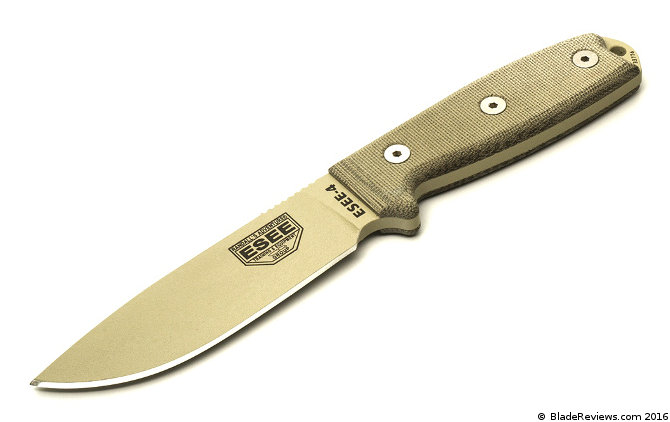
The geometry of the ESEE-4 drop point design makes it an excellent all-purpose knife. The large belly area makes it perfect for slicing. The lowered point in relation to the spine (hence the term “drop point”) dissipates energy as the cutting stroke approaches the point. This gives the user more control over the tip, which is very important during skinning and other survival tasks. The drop point also adds strength to the tip, and the thicker flat spine makes this knife excellent for batoning. The one disadvantage of the drop point design is that it is not as suitable for piercing as a spear point, tanto, or some other designs, but every blade design has its strengths and weaknesses.
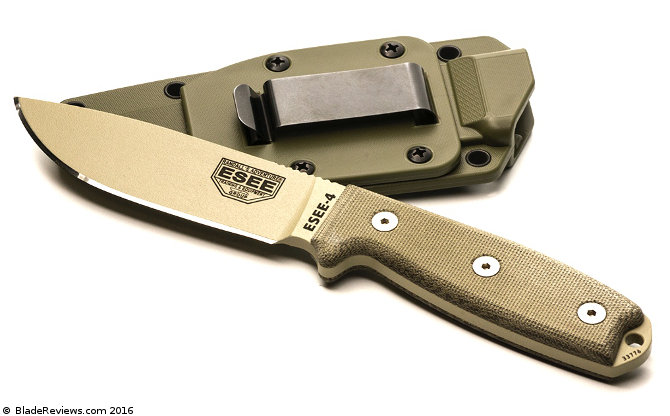
High carbon steels like 1095 are ideal for bushcraft/survival knives like this one. While these metal compositions are prone to rust if not properly cared for, their high carbon content make them easy to sharpen in the field. For a defensive blade, super steels like CPM S35VN and S30V are great because you can sharpen them in a controlled environment with high-tech sharpening systems like the Wicked Edge or Work Sharp; however, when you are in a survival situation and your knife is your lifeline, you want something that you can sharpen on whatever hard, abrasive surface might be available. Although ESEE powder-coats the knife, keeping the blade dry (especially the edge) and lightly lubricated with a rust inhibitor like TUF-GLIDE will prevent the ESEE-4 from staining or rusting.
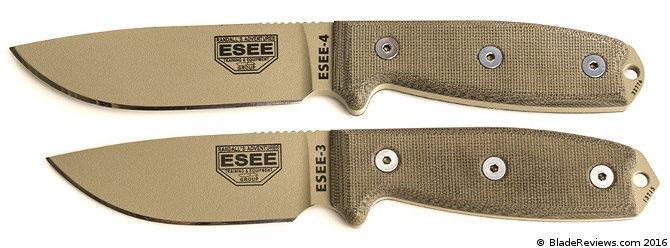
Editor’s note: ESEE recently released a version of the 4 with an uncoated 440C stainless steel blade. 440C is a hearty steel and probably a good choice for a outdoor focused fixed blade like the ESEE-4 if you are looking for something stainless. In addition to being more stain resistant, the uncoated version will slice better than the 1095 version of the ESEE-4, as ESEE’s powder coat is thick and textured. The trade off is that 440C is not as tough as 1095, and for that reason you lose ESEE’s lifetime warranty with the 440C version.
It would be cool to see ESEE offer this knife in 3V, which would theoretically give you the best of both worlds, but my guess is a 3V knife would add another $100 to the price tag.
Handle and Ergonomics
ESEE knives have a reputation for their handle ergonomics and the ESEE-4 is no exception. If you are acquainted with the ESEE-3, then you already know the ESEE-4 handle, because it is the exact same handle minus the additional 0.063” difference in metal thickness of the ESEE-4 over the ESEE-3. This is a simple and time-tested handle design.

The ESEE-4 handle fits very well in the hand and the linen Micarta handle scales provide a positive gripping surface dry or wet. When you really need to choke up on the knife for some fine blade manipulation, the large choil serves as an additional finger groove. The spine jimping offers an additional level of control for thumb-supported cutting and extends far enough forward that it can be used in conjunction with the finger-sized choil.
Sheath
The ESEE-4 comes with a friction-fit molded sheath that locks the knife very securely in place and has an attachment clip plate that can be mounted on either side of the sheath. This is an improvement over their original Kydex sheath that came with my first ESEE-4. Not that there is anything wrong with Kydex, but injection molding is a much more expensive process and the plastic does hold up to extremely hot temperatures better than Kydex, which is a plus if you live in the southwest and wish to keep a knife inside your car during the summer.
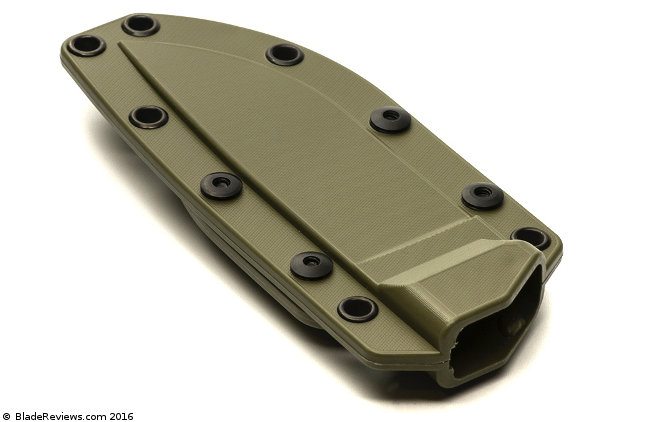
A length of 550 cord and a cord lock is also included with the knife. This cord may be used as a lanyard, or for lashing the sheath to a belt or pack. A quick shoelace-style threading of the cord through the eyelets of the sheath makes an excellent attachment point that can be locked down with the cord lock. There is also a MOLLE backing available (purchased separately) that can be worn as a drop leg sheath or attached to MOLLE gear.
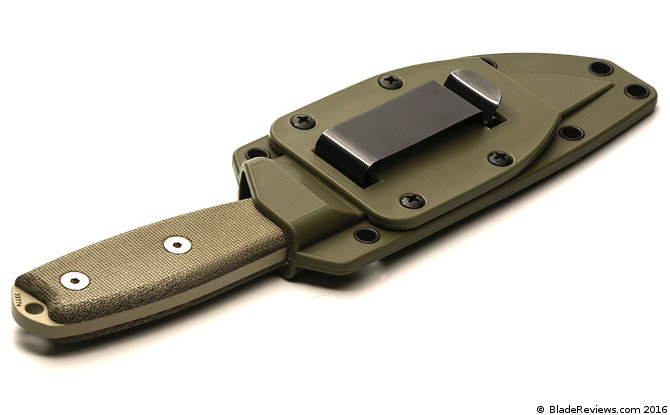
ESEE-4 Review – Final Thoughts
I have spent many nights curled up next to a campfire with an ESEE-4 in hand. This is without a doubt my favorite field knife, which has been used for making fuzz sticks, shaving tinder, cutting branches and rope, batoning wood, field dressing game, and a slew of other tasks, and has required very little maintenance. It is the simplicity of the design that makes it so desirable and user friendly. If you are looking for a reasonably sized, all-around outdoor knife, then I can’t recommend the ESEE-4 enough.
ESEE® offers a no questions asked lifetime warranty on all of their 1095 carbon steel knives. If it breaks, they will replace it. There are also a large number of Chinese knockoffs floating around on the internet, so do your homework before you buy.
- Blade Length: 4. 50"
- Cutting Edge: 4. 06"
- Blade Material: 1095 Carbon Steel
Editor: If you are thinking of buying an ESEE-4, please consider purchasing it at Amazon or BladeHQ. By purchasing things through any of the links on this website you support BladeReviews.com, keep the website free of annoying banner ads, and help produce future reviews. Thank you very much.
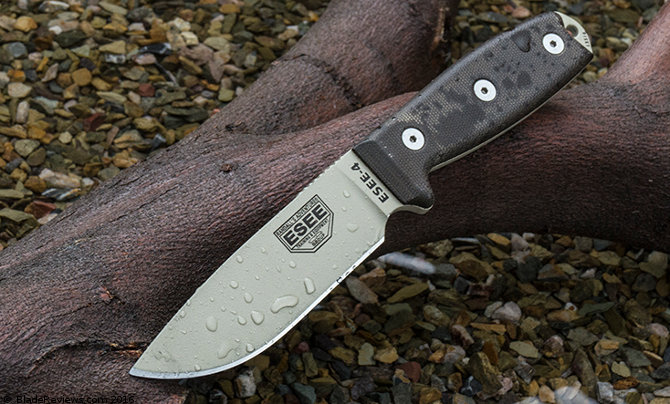
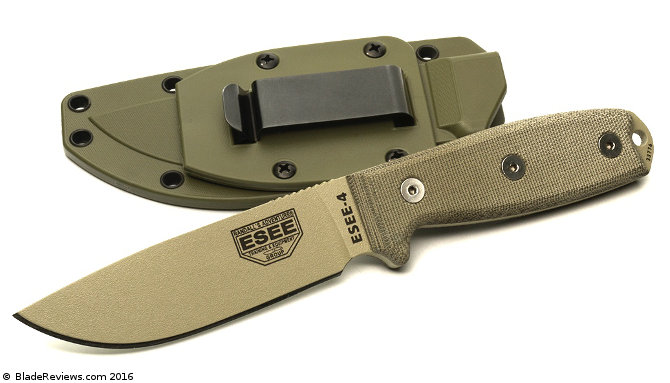

Nice review. It’s the right size & weight of fix blade for me.
I was checking on a TRC knife, TR13 recently. The blade & handle dimensions is same as ESEE 4, with the difference that TR13 is using Elmax (can opt to use M390).
I know Elmax is similar to CPM S30V, that is not rusting easily. However it’s not easily sharpened without the proper sharpening tools as you highlighted. So would you suggest to choose steel like 1095, D2 for survival/outdoor hard use fix knife?
By the way, what’s the handle thickness of this ESEE 4? The Ka Bar handle is a bit too fat to my liking.
Thanks.
I definitely recommend 1095, 5160, or other high-carbon steel for a survival or bush knife. You want something you can sharpen easily with whatever abrasive you can find. D2 and most super steels are too hard and require dedicated sharpening tools to maintain. I reserve those steels for EDC and defensive blades.
Thanks for clearing up in blade steel selection for different use.
Looks like ESEE 4 would fit the bill nicely.
Chad, did you take these photos? They’re stunning!
Yes, I did. Thank you!
A solid review of a very good knife and company.Rowen does a fantastic job with 1095 steel,and combined with the best warranty in the buisness an Esee knife is a very good choice for a wilderness survival knife.I couldn’t agree with you anymore when it comes to steel’s for a survival style knife.I can understand from a collector’s point of view to chase super steel’s,or for a folder,but for a fixed blade that will be used in the woods/field,you are much better off to stick with steel’s like 1095,1095 cro van,5160,1075,or even Aus8 and 420hc,due to toughness and ease of resharpening.Another very good steel that is not as widely known to fans yet is 80CRV2 steel.I own a Kellam M.07 in 80CRV2 and it is one tough knife that holds a very good working edge.If i were to pick two steel’s for a wilderness survival knife it would be 80CRV2 and 1095 cro van..
Nice review! It always seemed like the ESEE 4 was a good option for a no nonsense tool.
I do have a question, though. You say that the injection molded plastic is more resilient to heat than Kydex/PPS materials. Do you have a source for that? I tend to prefer Kydex for its rigidity, but I live in a comparably hot area and was wondering if the heat is a concern.
Thanks,
Grayson
Grayson,
My source is personal experience. Generally, Kydex is very good, but if it gets too hot it will start to loose its form. The temperature require for this is pretty high, so it only becomes a concern if the knife and sheath are allowed to bake in the sun. There have been a couple of times where I have forgotten a knife on the seat of the car, only to return to a sheath that had lost its retention.
If I had to choose between an ESEE4 or an ESEE5 for all around use, because I could only afford one, do you have a recommendation?
Personally, I would go with the ESEE4. I have messed around with both of them, and I personally like the size and feel of the ESEE4 the best.
Thanks. Just ordered one. Gonna test it in Hawaii
Would you recommend the esee 4 for a gutting, skinning game knife? I have my kabar knives for camp. I am really I am interested in this knife due to the bright colors they are available in so it won’t get lost in a gut pile at night in a field or woods.
Just picked up the ESEE4 at Smoky Mountain Knifeworks. I had a feeling that it was a quality knife from everything the salesman were saying about it, but it was great to read you review to confirm my feelings!
Thanks!
Hi Tim,
Thanks for stopping by and checking out the review. The ESEE-4 is a solid knife. The guys at SMKW know their stuff! Enjoy!
Dan
I just pulled the trigger on the ESEE 4 today. I read up on many different knives over the past two weeks. I found this review after I had purchased it on Amazon. I made the right choice. Thks!
Kirk,
Congrats on your purchase. The ESEE-4 is a fine blade and I think you are going to like it. Enjoy!
Dan
Howdy–
Thanks for a great, comprehensive review. I’ve got one coming from Blade HQ now, a 440c version. I was psyched to see on the Esee website that the stainless version is covered by the lifetime warranty–that may have changed since you wrote the review:
“Our stainless knives are warrantied just like our carbon steel knives. However, we advise that because they are hardened to a higher Rockwell hardness than our carbon steel knives, they are easier to break if you pry with them.”
Thanks again,
Ron
I couldn’t agree more with this review. I have abused mine for several years now. I also agree wholeheartedly with the author and his views on carbon steel for survival knife. I have experimented with several steels in the woods and always come back to carbon steel for the reasons mentioned.
Lots of folks shy away because of its tendency to rust, but, the benefits of the steel far outweigh this negative in my opinion and experience . Just get used to caring for your carbon steel blade and will serve you well.
Great review!